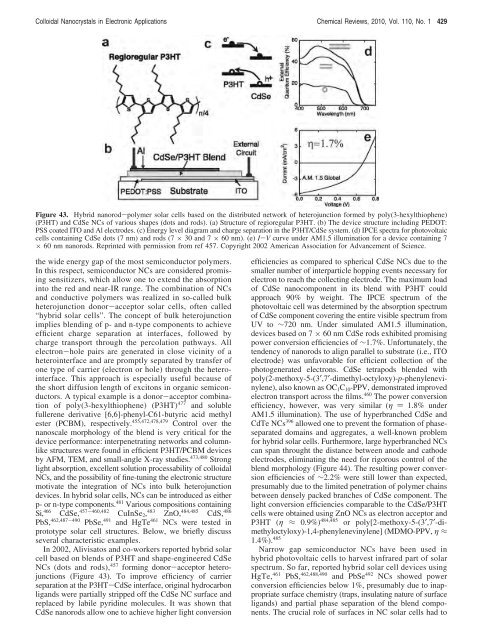Prospects of Colloidal Nanocrystals for Electronic - Computer Science
Prospects of Colloidal Nanocrystals for Electronic - Computer Science
Prospects of Colloidal Nanocrystals for Electronic - Computer Science
Create successful ePaper yourself
Turn your PDF publications into a flip-book with our unique Google optimized e-Paper software.
<strong>Colloidal</strong> <strong>Nanocrystals</strong> in <strong>Electronic</strong> Applications Chemical Reviews, 2010, Vol. 110, No. 1 429<br />
Figure 43. Hybrid nanorod-polymer solar cells based on the distributed network <strong>of</strong> heterojunction <strong>for</strong>med by poly(3-hexylthiophene)<br />
(P3HT) and CdSe NCs <strong>of</strong> various shapes (dots and rods). (a) Structure <strong>of</strong> regioregular P3HT. (b) The device structure including PEDOT:<br />
PSS coated ITO and Al electrodes. (c) Energy level diagram and charge separation in the P3HT/CdSe system. (d) IPCE spectra <strong>for</strong> photovoltaic<br />
cells containing CdSe dots (7 nm) and rods (7 × 30 and 7 × 60 nm). (e) I-V curve under AM1.5 illumination <strong>for</strong> a device containing 7<br />
× 60 nm nanorods. Reprinted with permission from ref 457. Copyright 2002 American Association <strong>for</strong> Advancement <strong>of</strong> <strong>Science</strong>.<br />
the wide energy gap <strong>of</strong> the most semiconductor polymers.<br />
In this respect, semiconductor NCs are considered promising<br />
sensitizers, which allow one to extend the absorption<br />
into the red and near-IR range. The combination <strong>of</strong> NCs<br />
and conductive polymers was realized in so-called bulk<br />
heterojunction donor-acceptor solar cells, <strong>of</strong>ten called<br />
“hybrid solar cells”. The concept <strong>of</strong> bulk heterojunction<br />
implies blending <strong>of</strong> p- and n-type components to achieve<br />
efficient charge separation at interfaces, followed by<br />
charge transport through the percolation pathways. All<br />
electron-hole pairs are generated in close vicinity <strong>of</strong> a<br />
heterointerface and are promptly separated by transfer <strong>of</strong><br />
one type <strong>of</strong> carrier (electron or hole) through the heterointerface.<br />
This approach is especially useful because <strong>of</strong><br />
the short diffusion length <strong>of</strong> excitons in organic semiconductors.<br />
A typical example is a donor-acceptor combination<br />
<strong>of</strong> poly(3-hexylthiophene) (P3HT) 477 and soluble<br />
fullerene derivative [6,6]-phenyl-C61-butyric acid methyl<br />
ester (PCBM), respectively. 455,472,478,479 Control over the<br />
nanoscale morphology <strong>of</strong> the blend is very critical <strong>for</strong> the<br />
device per<strong>for</strong>mance: interpenetrating networks and columnlike<br />
structures were found in efficient P3HT/PCBM devices<br />
by AFM, TEM, and small-angle X-ray studies. 473,480 Strong<br />
light absorption, excellent solution processability <strong>of</strong> colloidal<br />
NCs, and the possibility <strong>of</strong> fine-tuning the electronic structure<br />
motivate the integration <strong>of</strong> NCs into bulk heterojunction<br />
devices. In hybrid solar cells, NCs can be introduced as either<br />
p- or n-type components. 481 Various compositions containing<br />
Si, 466 CdSe, 457-460,482 CuInSe2, 483 ZnO, 484,485 CdS, 486<br />
PbS, 462,487-490 PbSe, 491 and HgTe 461 NCs were tested in<br />
prototype solar cell structures. Below, we briefly discuss<br />
several characteristic examples.<br />
In 2002, Alivisatos and co-workers reported hybrid solar<br />
cell based on blends <strong>of</strong> P3HT and shape-engineered CdSe<br />
NCs (dots and rods), 457 <strong>for</strong>ming donor-acceptor heterojunctions<br />
(Figure 43). To improve efficiency <strong>of</strong> carrier<br />
separation at the P3HT-CdSe interface, original hydrocarbon<br />
ligands were partially stripped <strong>of</strong>f the CdSe NC surface and<br />
replaced by labile pyridine molecules. It was shown that<br />
CdSe nanorods allow one to achieve higher light conversion<br />
efficiencies as compared to spherical CdSe NCs due to the<br />
smaller number <strong>of</strong> interparticle hopping events necessary <strong>for</strong><br />
electron to reach the collecting electrode. The maximum load<br />
<strong>of</strong> CdSe nanocomponent in its blend with P3HT could<br />
approach 90% by weight. The IPCE spectrum <strong>of</strong> the<br />
photovoltaic cell was determined by the absorption spectrum<br />
<strong>of</strong> CdSe component covering the entire visible spectrum from<br />
UV to ∼720 nm. Under simulated AM1.5 illumination,<br />
devices based on 7 × 60 nm CdSe rods exhibited promising<br />
power conversion efficiencies <strong>of</strong> ∼1.7%. Un<strong>for</strong>tunately, the<br />
tendency <strong>of</strong> nanorods to align parallel to substrate (i.e., ITO<br />
electrode) was unfavorable <strong>for</strong> efficient collection <strong>of</strong> the<br />
photogenerated electrons. CdSe tetrapods blended with<br />
poly(2-methoxy-5-(3′,7′-dimethyl-octyloxy)-p-phenylenevinylene),<br />
also known as OC1C10-PPV, demonstrated improved<br />
electron transport across the films. 460 The power conversion<br />
efficiency, however, was very similar (η ) 1.8% under<br />
AM1.5 illumination). The use <strong>of</strong> hyperbranched CdSe and<br />
CdTe NCs 396 allowed one to prevent the <strong>for</strong>mation <strong>of</strong> phaseseparated<br />
domains and aggregates, a well-known problem<br />
<strong>for</strong> hybrid solar cells. Furthermore, large hyperbranched NCs<br />
can span throught the distance between anode and cathode<br />
electrodes, eliminating the need <strong>for</strong> rigorous control <strong>of</strong> the<br />
blend morphology (Figure 44). The resulting power conversion<br />
efficiencies <strong>of</strong> ∼2.2% were still lower than expected,<br />
presumably due to the limited penetration <strong>of</strong> polymer chains<br />
between densely packed branches <strong>of</strong> CdSe component. The<br />
light conversion efficiencies comparable to the CdSe/P3HT<br />
cells were obtained using ZnO NCs as electron acceptor and<br />
P3HT (η ≈ 0.9%) 484,485 or poly[2-methoxy-5-(3′,7′-dimethyloctyloxy)-1,4-phenylenevinylene]<br />
(MDMO-PPV, η ≈<br />
1.4%). 485<br />
Narrow gap semiconductor NCs have been used in<br />
hybrid photovoltaic cells to harvest infrared part <strong>of</strong> solar<br />
spectrum. So far, reported hybrid solar cell devices using<br />
HgTe, 461 PbS, 462,488,490 and PbSe 492 NCs showed power<br />
conversion efficiencies below 1%, presumably due to inappropriate<br />
surface chemistry (traps, insulating nature <strong>of</strong> surface<br />
ligands) and partial phase separation <strong>of</strong> the blend components.<br />
The crucial role <strong>of</strong> surfaces in NC solar cells had to
















